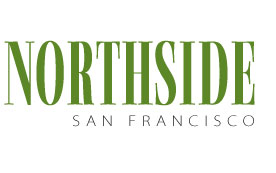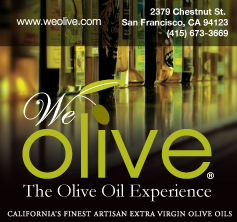| |
|

Cover Story
Ann Lazarus: Fort Mason Center visionary
By Mary Beth Starzel • Photos by Stephanie Secrest
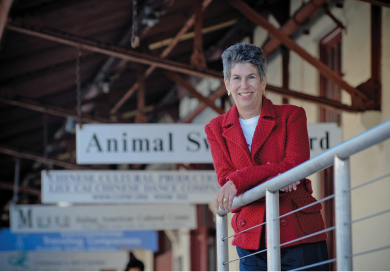 Ann Blumlein Lazarus first came to the Fort Mason Foundation in 2008 to be the interim executive director, a specialty niche she had pursued through positions at several top nonprofits in the Bay Area. But after an extensive search eliminated all other talented candidates, it was she who was appointed the new executive director early this year. Ann Blumlein Lazarus first came to the Fort Mason Foundation in 2008 to be the interim executive director, a specialty niche she had pursued through positions at several top nonprofits in the Bay Area. But after an extensive search eliminated all other talented candidates, it was she who was appointed the new executive director early this year.
A second-generation San Franciscan, Lazarus brings a wealth of talent, experience and knowledge of the community to the post. Savvy, smart and sophisticated, she seems the perfect fit for this San Francisco institution.
”Exactly,” says Ivar Chhina, president of the Fort Mason Foundation. “Ann is just wonderful. Clearly, she’s one of the best executive directors in the City and an absolute delight to work with. In the short time she’s been with us, we have moved Fort Mason objectives forward quite substantially, and I look forward to continuing that under her leadership,” he said.
Fort Mason, a 13-acre campus of historic landmark property on the waterfront between San Francisco’s Aquatic Park and the Golden Gate Yacht Club, is cited as a national model for the conversion of a military base to contemporary use. Part of the Golden Gate National Recreation Area, it’s been operated as a nonprofit organization since 1977 for the use of environmental, cultural and arts organizations, in addition to the lease of its event space for groups of up to 5,000 people.
Revenues come from 21 nonprofit “resident,” or tenant, organizations that lease long-term space, and from other occasional space rentals for events, large and small, that bring in 1.6 million people annually. (Coincidentally, that’s the same number of troops that embarked from the deep-water piers there in World War II.) It is managed by the Fort Mason Foundation, which holds a 60-year lease with the National Park Service, and is committed to making certain improvements to buildings and visitor experience at the site over time.
“Its unique waterfront location offers opportunities looking ahead,” Lazarus said. “We’ll be working on making this more a destination people might think of coming to for many reasons. Certainly, people are familiar with coming for a theater experience here or specific interaction with a particular resident, but we’re planning on expanding the opportunities they might have while they’re here for a total experience. We want to attract more people and make it more dynamic than it currently is,” she said.
For instance, a multifaceted summer program, Destination Fort Mason Center, A Waterfront Celebration of Art and the Environment, will be held between July 16 and Sept. 12, merging the numerous and ongoing activities of many groups for family and community fun. A new cafe-wine lounge is in the plans to offer visitors everything from morning coffee to after-theater refreshments, and should be operating by Labor Day. Zip cars, a membership car-sharing concept, are now available for pick up at Fort Mason. New outdoor science exhibits placed by the nearby Exploratorium make science approachable and aesthetic in the venue.
“Another goal is to enhance modes of transportation, including access to the water, probably on Pier 2, to link us to other parts of the waterfront, such as Fort Baker where convention-goers could stay across the bay and come here by water for their meetings. It’s not an enormous project and needs a little more work to prepare it. It’s very feasible,” she said.
“Also, there is only limited Muni service here now and we only have 400 parking spaces, so we are promoting the use of the nearby historic rail line tunnel that would join us with the area at the foot of Van Ness Avenue,” Lazarus added.
She now supervises a $6 million annual budget, 30 employees, and devotes time to strategic planning, fundraising and developing initiatives with the National Park Service. Lazarus oversees nine Mission Revival buildings – 1910 through 1914 vintage – with a total of 300,000 square feet of classroom, gallery, meeting room, office, and performance space, as well as a huge conference center. (The Herbst Pavilion accommodates 3,000 and the Festival Pavilion holds 5,000, with 437 seats in the Cowell Theater, a state-of-the-art performance space.)
Fort Mason residents include theaters; museums; a music school; a maritime library; and Greens, a nationally renowned gourmet vegetarian restaurant; along with a bookstore, several environmental groups, and many others – all of which have met the center’s criteria that include providing affordable services or activities to the community. About 15,000 events are slated here each year, including exhibits, fairs, lectures, festivals, performances, trade shows, weddings, classes, and workshops for all ages and interests. Major events include the San Francisco Art Institute MFA show, the San Francisco Fall Antiques Show, the Pacific Orchid Exposition, the Contemporary Crafts Market, and the Celebration of Craftswomen. There are also many food- and wine-related events. Check for current activities at www.fortmason.org.
Taking care of Fort Mason
Much like any 1912 structure, Fort Mason needs serious maintenance, too. Improvements and timing are spelled out in the lease agreement with the National Park Service, with the first phase already completed. That included $1,332,000 worth of preservation, improvements and the seismic retrofit of the Firehouse, Gatehouse and Guardhouse. Implementation of paid parking was also a component of Phase I.
The estimated $36.5 million Phase II will begin by the end of next year and will tackle improvements to Pier 2 including the Herbst Pavilion and Cowell Theater. “Per our lease agreement, we have required work on the roof and seismic repairs to make, but we intend to take advantage of the opportunity to do more that will really enhance the value of the space. It’ll be mostly interior work such as a new gallery, new lobby, enhancements to the theater and rehearsal space, and changes to the pavilion itself to make it more usable for more leases,” Lazarus stated. Some green energy modes are hoped for as well. (Funding will be achieved through commercial lending, philanthropic and capital campaign fundraising. Phase III, planned in 2020, involves the four large, multistory buildings at the site.)
“As long as you are in there doing the work, why not do it really well and leave a legacy for decades?” she asks. “It’s an opportunity we just can’t pass up,” she adds.
The question points to a basic philosophy: The joy of doing something well. “That’s the only way I know how. I’m not a perfectionist – you can’t let perfect stand in the way of the good – but if you have the opportunity to make improvements, they are worth undertaking.
“I’m fundamentally a ‘doer’ – more inclined to action than talk. That’s what works for me. I realize the need for planning, but in the long run you prove yourself by doing,” she said. That’s the core of her general operating philosophy, too. “Surround yourself with good, qualified individuals and let them do their work. Try to instill a sense of teamwork so everyone is contributing their expertise to that mission.”
The mission is closely tied to Fort Mason’s challenge: raising visibility, reminding people of everything that goes on at the facility, and to making some campus improvements so visitors have optimal experiences, Lazarus explained.
Economic challenges, too, are important now. “In these economic times, everyone is mindful of costs, but in some ways we offer a lower-cost alternative. We’re competitive, and there are types of events that can only be held in one or two of our large buildings. We have two rates – one for nonprofits – and we offer flexibility in pricing. For instance, you have a choice of caterers or decorators and could take advantage of a lower rate,” she added.
Lazarus’s thoughts on other matters:
• “We too often operate in silos when we could be collaborating. Why should you go it alone? We’re looking for alliances as long as it meets our general mission.”
• “My father told me to respect the integrity of the individual and trust their judgment until they make a mistake, when you can rein them in. It’s how people learn to make decisions and acquire judgment. I hope this is the way I raised my children!”
• “I’ve never found the same satisfaction as working in nonprofit organizations. They are more nimble and able to do things more quickly.”
• “The San Francisco nonprofit sector is still not recognized for what it contributes to our city. Probably there are too many nonprofit groups here now, and there is a need to look at combining some of those for reducing costs and providing nonduplicative services. The economic downturn might help look at relationships between agencies and philanthropy. It’s an interesting time and I hope we take advantage of it.”
“Fort Mason is a peculiar beast because we are largely self-sufficient, so we are not out soliciting support from the community at large,” says Lazarus, “We are a model of the adapted military base, a park partner, a national park. It’s an identity issue that we’re trying to tackle. People have a positive view of Fort Mason or what they do here, but don’t connect that with being at Fort Mason Center. And they don’t think of us as a park either: It defies the traditional notion of a park.”
“Ideally, if you wanted something interesting to do someday, you’d just come on down to Fort Mason, assured that you would find it there. It’s an exciting time for Fort Mason, and we just want to deliver on the vision. Many pieces make it fun and challenging.”
Mary Beth Starzel writes periodically
for Northside San Francisco as a
community resident.
Ann Blumlein Lazarus
Most recently, Ann Lazarus’s work experience has been as interim executive director, successively, of Enterprise for High School Students; Coro Center for Civic Leadership, San Francisco; and San Francisco School Volunteers, all major nonprofit organizations here. (She says the “fit” and the timing was right at Fort Mason for her to stay on as the executive director now.) She also was CEO at Mount Zion Health Fund and held a number of other private sector positions. Lazarus has both a B.A. in political science and an MBA from Stanford. Numerous responsible and prestigious volunteer jobs are on her resume as well.
Lazarus loves the Giants and the 49ers, and the San Francisco Ballet and orchestra. She loves to walk different neighborhoods in the City and to visit the glorious array of restaurants, especially new ones. She is married to Jim Lazarus, senior vice president for public policy at the San Francisco Chamber of Commerce. They raised four children in San Francisco.
Fort Mason History
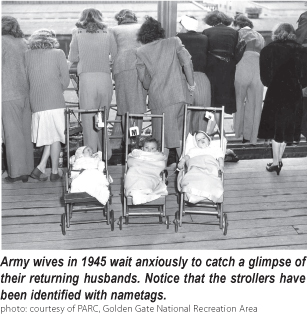
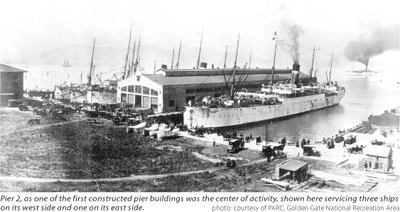
Pier 2, as one of the first constructed pier buildings was the center of activity, shown here servicing three ships on its west side and one on its east side. photo: courtesy of PARC, Golden Gate National Recreation Area
In all, Fort Mason is a unique contemporary site with a long history. It was first a coastal fortification in the 1860s when Union interests focused upon the Bay Area and built emergency installations here. It was named in 1882 after Richard Barnes Mason, a former military governor of California. Fort Mason received thousands of 1906 earthquake refugees cared for by the Army field relief operations, and by 1915 the three covered piers and large warehouses had been constructed for its service as the logistical and transport hub for Pacific embarkation and supply shipment programs, which lasted until 1965.
In 1972, Congress established the Golden Gate National Recreation Area as an urban park with several thousand acres of shoreline, including Fort Mason, now a National Historic Landmark. The Fort Mason Foundation was created in 1976 (operational in 1977) and now pursues a mission to create and preserve a cultural, educational and recreational center reflecting the unique history, talents and interests of the Bay Area people, in partnership with the National Park Service. Programs are made available at the lowest cost consistent with sound financial operation.


|
|
|
|
